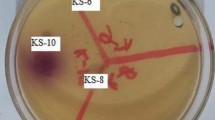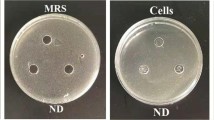Abstract
Lactocin 160 is a vaginal probiotic-derived bacteriocin shown to selectively inhibit the growth of Gardenerella vaginalis and some other pathogens commonly associated with bacterial vaginosis. The natural origin of this peptide, its safety, and selective antimicrobial properties make it a promising candidate for successful treatment and prophylaxis of bacterial vaginosis (BV). This study evaluated interactions between lactocin 160 and four other natural antimicrobials in the ability to inhibit G. vaginalis. We report that zinc lactate and soapnut extract act synergistically with lactocin 160 against this pathogen and therefore have a potential to be successfully used as the components of the multiple-hurdle antimicrobial formulation for the treatment of BV.


Similar content being viewed by others
References
Reid G (2001) Probiotic agents to protect the urogenital tract against infection. Am J Clin Nutr 73:437S–443S
Dover SE, Aroutcheva AA, Faro S, Chikindas ML (2008) Natural antimicrobials and their role in vaginal health: a short review. Int J Probiot Prebiot 3:219–230
Aroutcheva AA, Simoes JA, Faro S (2001) Antimicrobial protein produced by vaginal Lactobacillus acidophilus that inhibits Gardnerella vaginalis. Infect Dis Obstet Gynecol 9:33–39
Dover SE, Aroutcheva AA, Faro S, Chikindas ML (2007) Safety study of an antimicrobial peptide lactocin 160, produced by the vaginal Lactobacillus rhamnosus. Infect Dis Obstet Gynecol 2007:78248
Kant S, Maurya AK, Kushwaha RA, Nag VL, Prasad R (2010) Multi-drug resistant tuberculosis: an iatrogenic problem. Biosci Trends 4:48–55
McLean NW, McGroarty JA (1996) Growth inhibition of metronidazole-susceptible and metronidazole-resistant strains of Gardnerella vaginalis by lactobacilli in vitro. Appl Environ Microbiol 62:1089–1092
Nagaraja P (2008) Antibiotic resistance of Gardnerella vaginalis in recurrent bacterial vaginosis. Indian J Med Microbiol 26:155–157
Harwich MD Jr, Alves JM, Buck GA, Strauss JF III, Patterson JL, Oki AT et al (2010) Drawing the line between commensal and pathogenic Gardnerella vaginalis through genome analysis and virulence studies. BMC Genomics 11:375
Leistner L (2000) Basic aspects of food preservation by hurdle technology. Int J Food Microbiol 55:181–186
Curtis GD, Lee WH (1995) Culture media and methods for the isolation of Listeria monocytogenes. Int J Food Microbiol 26:1–13
Turovskiy Y, Ludescher RD, Aroutcheva AA, Faro S, Chikindas ML (2009) Lactocin 160, a bacteriocin produced by vaginal Lactobacillus rhamnosus, targets cytoplasmic membranes of the vaginal pathogen, Gardnerella vaginalis. Probiot Antimicrob Proteins 1:67–74
Aroutcheva A, Gariti D, Simon M, Shott S, Faro J, Simoes JA et al (2001) Defense factors of vaginal lactobacilli. Am J Obstet Gynecol 185:375–379
Andersch B, Forssman L, Lincoln K, Torstensson P (1986) Treatment of bacterial vaginosis with an acid cream: a comparison between the effect of lactate-gel and metronidazole. Gynecol Obstet Invest 21:19–25
Cherrington CA, Hinton M, Mead GC, Chopra I (1991) Organic acids: chemistry, antibacterial activity and practical applications. Adv Microb Physiol 32:87–108
McEntire JC, Montville TJ, Chikindas ML (2003) Synergy between nisin and select lactates against Listeria monocytogenes is due to the metal cations. J Food Prot 66:1631–1636
Bourne N, Stegall R, Montano R, Meador M, Stanberry LR, Milligan GN (2005) Efficacy and toxicity of zinc salts as candidate topical microbicides against vaginal herpes simplex virus type 2 infection. Antimicrob Agents Chemother 49:1181–1183
Chvapil M, Droegemueller W, Betts K, Heine W, Weinstein L (1980) Preliminary testing of the contraceptive collagen sponge. Obstet Gynecol 56:503–506
Nishikawa M, Ogawa K (2006) Inhibition of epsilon-poly-l-lysine biosynthesis in Streptomycetaceae bacteria by short-chain polyols. Appl Environ Microbiol 72:2306–2312
Hiraki J, Ichikawa T, Ninomiya S, Seki H, Uohama K, Seki H et al (2003) Use of ADME studies to confirm the safety of epsilon-polylysine as a preservative in food. Regul Toxicol Pharmacol 37:328–340
Yoshida T, Nagasawa T (2003) epsilon-Poly-l-lysine: microbial production, biodegradation and application potential. Appl Microbiol Biotechnol 62:21–26
Shima S, Matsuoka H, Iwamoto T, Sakai H (1984) Antimicrobial action of epsilon-poly-l-lysine. J Antibiot (Tokyo) 37:1449–1455
Francis G, Kerem Z, Makkar HP, Becker K (2002) The biological action of saponins in animal systems: a review. Br J Nutr 88:587–605
Kirk DD, Rempel R, Pinkhasov J, Walmsley AM (2004) Application of Quillaja saponaria extracts as oral adjuvants for plant-made vaccines. Expert Opin Biol Ther 4:947–958
Ojha P, Maikhuri JP, Gupta G (2003) Effect of spermicides on Lactobacillus acidophilus in vitro-nonoxynol-9 vs. Sapindus saponins. Contraception 68:135–138
Mengoni F, Lichtner M, Battinelli L, Marzi M, Mastroianni CM, Vullo V et al (2002) In vitro anti-HIV activity of oleanolic acid on infected human mononuclear cells. Planta Med 68:111–114
Rodriguez E, Seguer J, Rocabayera X, Manresa A (2004) Cellular effects of monohydrochloride of l-arginine, N-lauroyl ethylester (LAE) on exposure to Salmonella typhimurium and Staphylococcus aureus. J Appl Microbiol 96:903–912
Badaoui Najjar M, Kashtanov D, Chikindas ML (2007) Epsilon-poly-l-lysine and nisin A act synergistically against Gram-positive food-borne pathogens Bacillus cereus and Listeria monocytogenes. Lett Appl Microbiol 45:13–18
Asok KK, Mazumdar K, Dutta NK, Karak P, Dastidar SG, Ray R (2004) Evaluation of synergism between the aminoglycoside antibiotic streptomycin and the cardiovascular agent amlodipine. Biol Pharm Bull 27:1116–1120
Bonnet M, Rafi MM, Chikindas ML, Montville TJ (2006) Bioenergetic mechanism for nisin resistance, induced by the acid tolerance response of Listeria monocytogenes. Appl Environ Microbiol 72:2556–2563
Bonnet M, Montville TJ (2005) Acid-tolerant Listeria monocytogenes persist in a model food system fermented with nisin-producing bacteria. Lett Appl Microbiol 40:237–242
Patterson JL, Girerd PH, Karjane NW, Jefferson KK (2007) Effect of biofilm phenotype on resistance of Gardnerella vaginalis to hydrogen peroxide and lactic acid. Am J Obstet Gynecol 197:170–177
Acknowledgments
This research was sponsored by NIH Grant “Natural antimicrobials against bacterial vaginosis” NCCAM NIH R21AT002897-01. The authors thank Dr. Katia Sutyak Noll for the editorial work.
Author information
Authors and Affiliations
Corresponding author
Rights and permissions
About this article
Cite this article
Turovskiy, Y., Chikindas, M.L. Zinc Lactate and Sapindin Act Synergistically with Lactocin 160 Against Gardnerella vaginalis . Probiotics & Antimicro. Prot. 3, 144–149 (2011). https://doi.org/10.1007/s12602-011-9068-5
Published:
Issue Date:
DOI: https://doi.org/10.1007/s12602-011-9068-5




